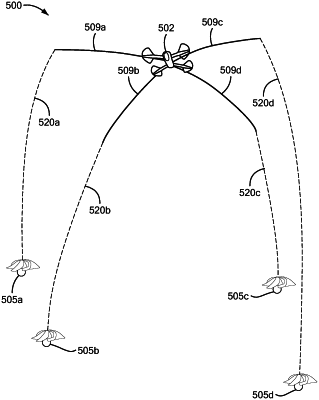| CPC B64C 39/024 (2013.01) [B64D 3/02 (2013.01); F41J 2/00 (2013.01); G05D 1/104 (2013.01); G05D 1/1064 (2019.05); B64U 10/10 (2023.01); B64U 30/20 (2023.01); B64U 2101/30 (2023.01); B64U 2201/102 (2023.01); B64U 2201/20 (2023.01)] | 20 Claims |

|
1. An assembly configured for connection to a single unmanned aerial vehicle (UAV), the assembly comprising:
a plurality of emulator devices each configured for attachment to a single UAV, each respective emulator device comprising a first emulation component, the first emulation component configured to provide, to a target detection system, a detectable feature that represents a first characteristic associated with a respective type of airborne object being emulated, the detectable feature comprising at least one of a scattering pattern of the airborne object and a signal return associated with one or more moving parts at or in the airborne object; and
a plurality of respective first connection tethers each configured to operably couple a respective one of the plurality of emulator devices to the single UAV at a desired respective spacing from the single UAV and configured to allow the single UAV to fly freely when the single UAV is connected to the assembly, each respective first connection tether formed such that at least a portion of each respective connection tether comprises a respective material that is configured so that it does not substantially reflect RF energy;
wherein each of the plurality of respective first connection tethers associated with the plurality of respective emulator devices, is constructed and arranged so that, after coupling the assembly to the single UAV, each of the plurality of respective emulator devices maintains the desired respective spacing from the single UAV when the single UAV is flying freely while towing the assembly and wherein at least one of the plurality of respective first connection tethers is configured to have a respective length that is dynamically adjustable, while the UAV is airborne and flying freely, so as to increase and decrease the desired respective spacing between the single UAV and a corresponding emulator device that is operably coupled to the single UAV via the at least one of the plurality of respective first connection tethers;
wherein the assembly is configured so that, when it is connected to the single UAV, the assembly does not constrain the single UAV from becoming airborne and flying freely while towing the assembly, wherein, during a flight of the single UAV that is connected to the assembly, the single UAV is not physically connected to any entities other than the assembly and wherein the assembly is not physically connected to any entities other than the single UAV; and
wherein the assembly, when connected to the single UAV, is configured so that each respective emulator device emulates the first characteristic to the target detection system, such that, during the flight of the single UAV while towing the assembly, the assembly presents, to the target detection system, a plurality of first characteristics that together emulate a grouping comprising a plurality of airborne objects that are each flying individually; and
wherein the increase and decrease of the desired respective spacing between the single UAV and the corresponding emulator device is configured to simulate a change in one or more detectable features of the grouping of airborne objects.
|